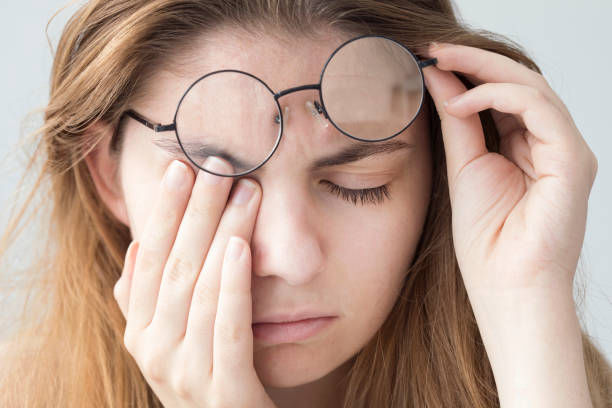Seeing black spots in vision can be a disconcerting and worrying experience. These spots, often referred to medically as floaters, scotomas, or visual artifacts, are visual disturbances that appear in the field of vision. They can manifest as small dots, cobweb-like shapes, specks, shadows, or threadlike structures that drift as your eyes move. While many cases are harmless, some can indicate serious eye or systemic conditions. Understanding their nature, causes, symptoms, and treatment options is crucial for maintaining eye health and overall well-being. This article delves into the phenomenon in depth.
1. Understanding Black Spots in Vision
Black spots in vision are subjective visual experiences where individuals perceive dark shapes in their visual field. The medical term for these is floaters, which typically float in the vitreous humor—the gel-like substance filling the interior of the eye. Floaters are often more noticeable when looking at bright, plain backgrounds, such as a clear sky or a white wall.
While floaters are commonly age-related and benign, black spots can also arise from other causes including retinal disorders, ocular migraines, eye injuries, systemic diseases, or neurological conditions.
Types of Black Spots
| Type | Description |
|---|---|
| Floaters | Small dots, cobwebs, or threadlike shapes in the visual field, caused by clumps in the vitreous gel. |
| Scotomas | Partial loss of vision or blind spots, often linked to retinal or optic nerve issues. |
| Ocular Migraines | Temporary visual disturbances including shimmering spots, zigzag lines, or dark areas, usually accompanied by headache. |
| Retinal Detachment | Dark spots or shadows appearing suddenly, often accompanied by flashes of light. |
| Eye Injury or Trauma | Dark spots or floaters appearing due to physical damage to the eye structure. |
The variation in type, pattern, and frequency of these black spots can provide clues to their underlying causes.
2. Causes of Black Spots in Vision
Black spots can result from a wide range of causes, from benign age-related changes to medical emergencies. It is crucial to distinguish between harmless floaters and signs of serious eye conditions.
2.1 Age-Related Vitreous Changes
As people age, the vitreous humor naturally degenerates and becomes more liquid. Collagen fibers within the vitreous may clump together, casting shadows on the retina, which are perceived as black spots. This type of floater is generally harmless but can increase in number with age.
2.2 Retinal Conditions
Serious retinal conditions can cause black spots and may require immediate attention:
| Condition | Description | Symptoms |
|---|---|---|
| Retinal Tear | A small break in the retina, sometimes leading to retinal detachment. | Sudden appearance of floaters, flashes of light, or a shadow over vision. |
| Retinal Detachment | Separation of the retina from the underlying tissue. | Black curtain or shadow in vision, sudden increase in floaters, blurred vision. |
| Diabetic Retinopathy | Damage to retinal blood vessels due to high blood sugar. | Dark spots, blurred vision, difficulty seeing colors, possible vision loss. |
| Macular Degeneration | Degeneration of central retina affecting detailed vision. | Dark or blind spots in central vision, distorted vision. |
Prompt diagnosis is essential to prevent permanent vision loss.
2.3 Eye Trauma
Injuries to the eye, including blunt trauma or exposure to chemicals, can damage the vitreous or retina. Even minor injuries may lead to small floaters or persistent dark spots.
2.4 Ocular Migraines
Ocular migraines, also called visual migraines, can temporarily cause black spots or shimmering patterns in vision, often accompanied by headache, light sensitivity, or nausea. These episodes are typically transient, lasting 15–30 minutes, but can be alarming if experienced for the first time.
2.5 Systemic Conditions
Certain systemic diseases or medications may contribute to the appearance of black spots in vision:
| Systemic Factor | Impact on Vision |
|---|---|
| Hypertension | High blood pressure may damage retinal vessels causing scotomas. |
| Diabetes | Blood sugar fluctuations can lead to diabetic retinopathy. |
| Migraines | Neurological changes during migraines can induce visual disturbances. |
| Medication Side Effects | Drugs such as chloroquine or corticosteroids can affect retinal function. |
2.6 Eye Infections and Inflammation
Inflammatory conditions such as uveitis or vitreitis can increase floaters and produce dark spots in vision. These conditions may be accompanied by eye redness, pain, or light sensitivity.
3. Symptoms Associated with Black Spots in Vision
The appearance of black spots can be associated with a spectrum of symptoms. Recognizing these symptoms helps determine whether medical attention is required.
Common Symptoms
- Small dots, threads, or cobweb-like shapes drifting across vision.
- Dark or blind spots in the central or peripheral visual field.
- Flashes of light (photopsia), especially with retinal issues.
- Blurred or distorted vision.
- Headache, nausea, or aura with ocular migraines.
- Sudden onset of multiple floaters may indicate retinal tear or detachment.
Symptom Table by Cause
| Cause | Visual Symptom | Additional Symptom |
|---|---|---|
| Floaters | Small drifting dots | Usually none; chronic but benign |
| Retinal Tear | Sudden black spots | Flashes, peripheral vision shadow |
| Retinal Detachment | Shadow/curtain effect | Rapid vision loss, urgent emergency |
| Ocular Migraine | Zigzag or shimmering black spots | Headache, nausea, light sensitivity |
| Diabetic Retinopathy | Dark spots or blurred patches | Gradual vision changes, floaters |
| Eye Trauma | Dark specks or streaks | Pain, swelling, redness |
Understanding these patterns helps both patients and healthcare providers differentiate between minor and urgent cases.
4. Diagnosis of Black Spots in Vision
A thorough eye examination is essential for determining the cause of black spots. Eye specialists use several techniques:
4.1 Comprehensive Eye Exam
- Visual acuity test to check clarity of vision.
- Dilated eye exam to examine the retina and vitreous.
- Slit-lamp examination to inspect eye structures.
4.2 Imaging and Advanced Tests
- Optical Coherence Tomography (OCT): Detects retinal thickness and structural changes.
- Fundus Photography: Visualizes the retina for abnormalities.
- Ultrasound Imaging: Useful when the vitreous is opaque or cloudy.
- Fluorescein Angiography: Highlights blood vessels in the retina to detect leakage or blockage.
Prompt diagnosis is crucial, especially if black spots appear suddenly, increase in number, or are accompanied by flashes of light. Early detection of retinal detachment or other serious conditions can save vision.
5. Treatment Options
Treatment depends on the underlying cause of black spots in vision. Many cases, especially age-related floaters, do not require intervention. However, specific conditions may require medical or surgical management.
5.1 Non-Surgical Management
- Observation: Most age-related floaters gradually become less noticeable over time.
- Vision Correction: Prescription glasses or contact lenses may improve visual clarity.
- Lifestyle Modifications: Controlling blood sugar, blood pressure, and reducing stress can limit progression.
- Migraine Management: Identifying triggers and using prescribed medications can reduce ocular migraine episodes.
5.2 Surgical Options
- Vitrectomy: A surgical procedure that removes the vitreous gel containing floaters. Used only in severe or vision-impairing cases due to risks such as retinal detachment or cataracts.
- Laser Treatment (Laser Vitreolysis): Breaks up large floaters into smaller, less noticeable fragments. Suitable for select cases with significant visual disruption.
5.3 Medical Treatment
- Treatment of underlying systemic conditions like diabetes, hypertension, or inflammatory eye diseases is critical.
- Anti-inflammatory eye drops or corticosteroids may be prescribed for ocular inflammation.
6. Prevention and Lifestyle Considerations
While some causes of black spots cannot be prevented (e.g., age-related changes), adopting a healthy lifestyle can reduce risk and progression.
Preventive Measures
- Regular eye exams, especially after age 40.
- Control of chronic diseases such as diabetes and hypertension.
- Wearing protective eyewear to prevent trauma.
- Adequate hydration and balanced nutrition rich in antioxidants and vitamins A, C, and E.
- Avoiding smoking and excessive alcohol consumption, which can accelerate eye degeneration.
- Managing migraines through stress reduction, diet, and appropriate medication.
Diet and Eye Health
A diet supporting retinal and vitreous health can play a role in reducing visual disturbances. Include:
| Nutrient | Food Sources | Benefits |
|---|---|---|
| Vitamin A | Carrots, spinach, kale | Maintains retinal function |
| Vitamin C | Citrus fruits, bell peppers | Reduces oxidative damage |
| Vitamin E | Nuts, seeds, avocados | Protects eye tissues |
| Omega-3 Fatty Acids | Fish, flaxseed | Supports retinal and vascular health |
| Zinc | Meat, legumes, pumpkin seeds | Supports visual processing |
A nutrient-rich diet combined with regular exercise supports overall ocular and systemic health.
7. When to See a Doctor
Immediate medical consultation is necessary if black spots in vision appear suddenly, especially if accompanied by any of the following:
- Flashes of light.
- A shadow or curtain over part of vision.
- Sudden increase in number or size of floaters.
- Eye pain, redness, or swelling.
- Loss of central or peripheral vision.
These symptoms could indicate retinal detachment, tear, or serious systemic conditions that require urgent intervention.
8. Prognosis and Outlook
The outlook for individuals with black spots in vision varies:
- Benign Floaters: Usually stable, may diminish over time, do not threaten vision.
- Retinal Issues: With prompt treatment, retinal tears or detachments can often be repaired, though delayed treatment increases risk of permanent vision loss.
- Ocular Migraines: Typically temporary and self-limiting; lifestyle and medication management can reduce frequency.
- Systemic Causes: Controlling underlying conditions like diabetes and hypertension significantly improves long-term eye health.
Overall, proactive eye care, timely diagnosis, and management of underlying causes improve both visual and systemic outcomes.
9. Mental and Emotional Impact
Persistent black spots or sudden changes in vision can lead to anxiety, stress, and reduced quality of life. Many individuals experience fear of blindness or difficulty performing daily tasks. Addressing these mental health aspects, alongside medical treatment, is important. Support groups, counseling, or patient education can help alleviate stress and improve adaptation to visual changes.
10. Emerging Research and Future Directions
Ongoing research in ophthalmology continues to explore safer, minimally invasive techniques for managing black spots. Some notable areas include:
- Advanced laser therapies for precise floaters removal.
- Vitreous regeneration studies to restore vitreous gel consistency and reduce floaters.
- Improved retinal imaging for earlier detection of scotomas and retinal detachment.
- Development of nutritional supplements targeting retinal and vitreous health.
These advancements promise more effective, lower-risk solutions for both cosmetic and medical concerns related to black spots in vision.
11. Summary Table: Black Spots in Vision
| Aspect | Key Points |
|---|---|
| Causes | Age-related vitreous changes, retinal disorders, ocular migraines, trauma, systemic diseases |
| Symptoms | Floaters, scotomas, flashes, blurred vision, light sensitivity |
| Diagnosis | Eye exam, OCT, fundus photography, ultrasound, fluorescein angiography |
| Treatment | Observation, lifestyle changes, vitrectomy, laser therapy, systemic condition management |
| Prevention | Regular eye checkups, protective eyewear, healthy diet, chronic disease control |
| Warning Signs | Sudden onset, flashes, curtain shadow, rapid increase in floaters, vision loss |
12. Conclusion
Black spots in vision, though often harmless, can sometimes signal serious ocular or systemic conditions. Recognizing the differences between benign floaters, retinal disorders, ocular migraines, and other causes is crucial for timely intervention. Regular eye examinations, a balanced diet, protective measures, and managing chronic diseases can reduce the risk and impact of black spots.
For individuals experiencing sudden changes, flashes, or a curtain-like shadow in vision, prompt consultation with an eye specialist is essential. With modern diagnostic tools, treatment options, and preventive measures, most causes of black spots in vision can be managed effectively, ensuring long-term eye health and preserving quality of life.
FAQs
1. Are black spots in vision always serious?
Not always. Age-related floaters are usually harmless, but sudden onset or accompanying flashes may indicate serious retinal issues.
2. Can black spots go away on their own?
Yes, benign floaters often become less noticeable over time as the brain adapts, but they may persist in some individuals.
3. How are black spots in vision diagnosed?
Eye specialists use comprehensive eye exams, OCT, fundus photography, and sometimes ultrasound to determine the cause.
4. When should I see a doctor for black spots?
Seek urgent care if black spots appear suddenly, increase rapidly, or are accompanied by flashes, shadows, or vision loss.
5. Can lifestyle changes reduce black spots?
Yes, maintaining eye health through diet, hydration, chronic disease control, and protective eyewear can help prevent or limit their progression.









